Vector Databases Types
Are you intrigued by the limitless possibilities of artificial intelligence but bewildered by the types of vector databases and libraries available? If so, you’re in the right place. In this blog post, we’ll demystify the world of AI by exploring the diverse landscape of vector databases and libraries essential for your projects.
As AI continues to reshape technology, understanding these tools is crucial, whether you’re a seasoned data scientist, Developer or just beginning your AI journey.
- For Developers: No ML expertise is needed. Can use open-source models and autoML tools to create embeddings. Populate the vector database to build vector search applications.
- For Data Engineer: Can build custom embeddings tuned for your use case. Vector database makes it easy to deploy models to production. Accelerates delivery of AI solutions.
- For Ops Teams: Manageable like other database workloads. Can leverage existing tools, monitoring, and playbooks. Easier to operationalize than other AI components.
By the end of this post, you’ll not only comprehend the various vector database types at your disposal but also feel confident in choosing the perfect match for your AI endeavors. Say goodbye to wasted hours and confusion, and say hello to the knowledge and tools you need to turn your AI ideas into reality. Ready to embark on this AI adventure? Let’s dive in!
What is a Vector Database – Explained Like I Am 5
The term “vector database” refers to a database that stores and manages data in vector embeddings (high-dimensional vectors) to make it easier to find and retrieve similar objects quickly.
Imagine you have a magical box of different toys, like action figures, cars, and stuffed animals. Now, you don’t know their names or colors, but you have a special friend who’s really good at guessing what toy you want to play with.
Your friend asks you questions like, “Is it big or small?” or “Does it have wheels or not?” Based on your answers, your friend can quickly find the right toy for you, even though they don’t know the toy’s name or color.
In the world of computers and artificial intelligence, there are these things called vector databases. These databases are like your magical box of toys, and they store lots of information about different things, but they don’t always know the names or colors. However, they’re super good at asking questions and figuring out what you’re looking for.
So, if you need to find something, like pictures of cats or information about a specific topic, these vector databases can ask you questions (in the form of numbers and math), and based on your answers, they quickly find what you’re searching for, just like your friend finds your toys.
These databases organize information by asking questions and using clever math to help you find what you want on the internet or in big collections of data.
What are Vector Embeddings?
Vector embeddings are a mathematical representation of objects like words, images, documents, etc. as numeric vectors. Each object gets encoded as an array of numbers that represents that item in multi-dimensional vector space. The values in the vector capture the meaning, relationships, and context of the object.
For example, word embedding represents the meaning of a word as a vector based on its semantic context. Words with similar meanings will have closer vectors. This allows AI applications to understand concepts and similarities between objects.
This vector format allows the database to understand relationships and similarities between objects. It can quickly find other similar vectors when you search – such as finding related documents, faces, or songs.
Traditional databases only understand keywords and surface attributes. But a vector database handles more complex information, like multidimensional data or vectors. It understands concepts, relationships, and context, which is widely used in recommendation systems, semantic search, and anomaly detection, where they deal with high-dimensional vectors. So you can search, organize and analyze complex data more intelligently.
Similarity search, anomaly search, observability, fraud detection, and IoT sensor analytics are all areas where vector databases are designed to handle critical queries and algorithmic styles. The rise of generative AI and digital transformation is responsible for such emerging styles.
Using similarity search, Google, for instance, recommends music and movies based on a user’s interests and those of others. The importance of similarity search goes beyond Google to all applications that recommend products, detect fraud through patterns of access, and even identify data quality problems.
Why Vector Databases Are Important?
In the realm of data management and search capabilities, vector databases have emerged as essential tools for modern applications. These databases hold a unique advantage that sets them apart: the ability to swiftly and precisely retrieve data through vector distance or similarity.
This section will delves into the significance of vector databases, shedding light on why they play a pivotal role in enhancing data-driven operations.
- Vector databases are vital due to their ability to swiftly retrieve data through vector similarity, bolstered by advanced embedding techniques.
- These databases excel in fast and accurate similarity searches, identifying data points with similarities using embedded vector representations.
- Precision is achieved through vector distance measurement, allowing for identification of exact and approximate matches, crucial for intricate data relationships.
- Vector databases enable real-time decision-making by providing quick access to relevant data, essential for applications like recommendation systems and fraud detection.
- Beyond immediate search, vector databases drive innovation in areas like image recognition, semantic search, and anomaly detection, enhancing data-driven applications.
Benefits of Vector Database
Instead of starting from scratch and building complex systems, vector databases offer a different way. They’re like a solid base that developers can use to build on. This is better than using a specific kind of system that’s known as a k-nearest neighbors (k-NN) index because that requires a lot of special knowledge and work to set up and run.
Here are the following benefits of vector databases
- Efficient Similarity Searches
- High-Dimensional Data Handling
- Fast k-Nearest Neighbor (k-NN) Search
- Advanced Information Retrieval
- Machine Learning Integration
- Scalability
- Simplicity for Developers
- Cross-Domain Applicability
- Reduced Infrastructure Complexity
Key Components of Vector Database
There are three key components of vector databases:
1. Vector Representation And Storage
It converts raw data like images, text, etc into a vector format. Different techniques are used depending on the data complexity. The vectors are then stored efficiently.
For Example
> Images can be represented using pixel values or feature extraction techniques.
> Text documents can be represented using bag-of-words models or word embeddings.
The vector representation method impacts the quality and efficiency.
2. Indexing and Querying
Indexes are built on vectors to enable fast similarity search. Different indexing methods prioritize speed or accuracy. The indexes power capabilities like finding similar vectors or anomalies.
For Example
> Tree-based methods partition the vector space into hierarchical regions.
> Hashing-based methods map the vectors into binary codes.
> Quantization-based methods compress the vectors into smaller representations.
The indexing method affects the trade-off between the speed and accuracy of the queries.
3. Integration With ML Frameworks
The database connects with external machine-learning tools and models. This allows seamless training and deployment of vector models. Integrations use standard formats like Apache Arrow or custom connectors.
For Example
> Apache Arrow provides a common format for exchanging data between different frameworks.
> Faiss provides a Python interface for accessing its C++ library.
> TensorFlow provides a built-in module for performing ANN search on its tensors.
How Does Vector Databases Work?
Vector databases store and index vector embeddings to enable fast retrieval and similarity search. A vector database uses a combination of different algorithms that all participate in Approximate Nearest Neighbor (ANN) algorithms to optimize the search process. These algorithms rely on techniques like hashing, quantization, or graph-based search.
The goal of ANN search is to find the vectors most similar vectors to a given query vector in a database. The similarity between two vectors can be measured using different metrics like cosine similarity or Euclidean distance. The higher the similarity score, the closer the two vectors are in space.
For Example
Imagine if we have a query sentence “What is the best meal for cats?”. Using machine learning, we calculate its embedding and then use a vector database to find the most similar sentences in our database. The vector database will return a ranked list of sentences with their similarity scores, such as:
“Recommended diets for feline friends” (Similarity: 0.94)
“Top food choices to keep your cat healthy” (Similarity: 0.91)
“Choosing the right nutrition for your kitty” (Similarity: 0.88)
In this scenario, the vector database highlights sentences that are closely related in content to your original query about the best meal for cats. This approach helps you quickly access information that corresponds to your topic of interest.
The same process can be applied to other types of data, such as images, audio, or video.
A vector database is also known as a vector search or similarity search database. It is designed to store, organize, and retrieve data in a way that allows finding similar items quickly. Now, let’s break down how this works:
Step 1: Understanding Vectors
At the core of vector databases lies the concept of vectors – numerical representations of data points in a multi-dimensional space. These vectors encapsulate the characteristics of the data they represent. Whether it’s images, text, or any other form of information, vectors serve as the building blocks that enable meaningful comparisons and associations.
Step 2: Indexing
Once the data is transformed into vectors, vector databases employ indexing techniques to organize and store these vectors efficiently. Indexing structures are meticulously designed to enable rapid retrieval of vectors based on their similarities or distances. This stage lays the groundwork for efficient data access and quick search operations.
Step 3: Searching for Similarity
The heart of vector databases’ operation lies in their ability to perform similarity searches. When a query vector is introduced, the database scans its indexed vectors to identify those that are most similar in terms of vector distance. This process involves sophisticated algorithms that measure the closeness of vectors and identify potential matches.
Step 4: Scoring Similarity
Once the potential matches are identified, a scoring mechanism comes into play. This mechanism assigns similarity scores to each potential match, quantifying the degree of similarity between the query vector and the stored vectors. This scoring process lays the foundation for ranking the retrieved results based on their resemblance to the query.
Step 5: Ranking and Retrieval
Finally, the database makes a list of data based on their similarity scores. The data with the highest scores are at the top of the list because they’re the closest matches. This way, you can quickly find items in the database that are most similar to your query.
Here’s a comparison: Think of the database as a huge library where each book has a special code (like our list of numbers) or (vector). When you ask the librarian (the database) what kind of book you want, they quickly compare the description (the query vector) of your desired book to all the books in the library. Then they give you a list of books that match your description the most.
Vector databases are used in various applications, such as image and video search, recommendation systems, natural language processing, and more. They make it possible to find similar items in massive datasets quickly and efficiently, which is essential in today’s data-driven world.
Applications of Vector Databases in the Business World
In the business world, vector databases offer significant potential for a variety of applications, transforming how companies handle, analyze, and derive insights from data.
1. Recommendation Systems: Enhancing Customer Experience
Have you ever wondered how e-commerce platforms seem to magically know what products you might be interested in? The answer lies in recommendation systems based on vector databases.
These systems employ vectors to represent users and items (like products). Comparing these vectors helps determine suitable items to suggest to users. Using these vectors, businesses can provide tailored product suggestions to customers, improving their shopping experience and boosting conversions.
2. Semantic Search: Unlocking Efficient Data Retrieval
Vector databases are highly useful in improving the efficiency and accuracy of semantic searches in information retrieval and natural language processing (NLP). Through techniques like word embeddings and transformers, text data is transformed into vectors. This transformation enables businesses to conduct searches for similar words, phrases, or even entire documents with exceptional efficiency and accuracy.
3. Anomaly Detection: Safeguarding Against Threats
Security and fraud detection has never been more critical for businesses. Vector databases offer a potent tool for identifying anomalous behavior.
By representing normal and abnormal patterns as vectors, businesses can rapidly identify potential threats or fraudulent activities through similarity searches. This proactive approach empowers organizations to stay ahead of security breaches and safeguard their operations.
4. Personalized Marketing: Tailoring Experiences for Success
Personalized marketing is crucial in today’s competitive business world. Vector databases help companies create customer profiles based on interactions and behavior. This enables the offering of tailored services and products.
Actions like browsing history, social media engagement, and past purchases can be represented as vectors in a multi-dimensional space. Businesses can identify patterns and groups in this space to understand precise customer preferences and effectively target them with personalized marketing efforts.
5. Image Recognition: Seeing the Future Clearly
The world of image recognition is undergoing a revolution with the integration of vector databases. Complex images are transformed into high-dimensional vectors using cutting-edge techniques like convolutional neural networks (CNN).
For example, a facial recognition system can store vector representations of faces. When a new face image is introduced, the system can compare it with vectors in the database to find the most similar faces.
6. Bioinformatics: Unraveling Biological Complexities
In the realm of bioinformatics, vector databases offer a pivotal resource for storing and querying genetic sequences, protein structures, and other biological data represented as high-dimensional vectors.
Researchers can identify similar genetic sequences or protein structures by locating similar vectors. This aids in advancing our knowledge of biological systems and diseases.
7. Knowledge Graphs
Vector databases can help build and query knowledge graphs that store facts and relationships between entities.
For instance, a vector database proves invaluable in responding to inquiries about entities or notions, like “Who currently holds the position of the president in France?” or “Which city serves as the capital of Australia?”.
8. Media Understanding and Similarity
Vector databases have a pivotal role in enhancing image comparison by eliminating distortions and noise, leading to a clearer understanding of images. Through the process of encoding and subsequent comparison, a deeper insight into these images is achieved. This technology finds broad and diverse applications, spanning fields such as medical imaging, oil exploration, security, surveillance, and even public transportation automation.
Similarity searches with images, for example, help monitor real-time traffic more efficiently. Through video-to-image technology, AI extracts each frame and evaluates each car on its similarity to others.
Once encoded in real-time this application can perform traffic analysis, be used to keep conditions safe and secure, and alert the public or law enforcement of potential problems. Analysis and correlation of details about cars, locations, and other traffic data allow us to make better choices regarding public transportation and traffic safety.
9. Data Quality, Deduplication, and Record Matching
Vector similarity search has proven useful for record matching and deduplication, especially for data quality, integration, and analytics. By identifying semantic similarities, differences, and errors, vector similarity algorithms can assist in finding duplicate data. This helps enhance data catalogs and point analysts to new, relevant data sources.
One application is processing enterprise data to remove cloned content from catalogs. Removing duplicates improves catalog usability. Additionally, suggesting new data sources to analysts can enhance the accuracy and quality of future analytics.
Top 10 Vector Databases & Libraries in 2024
In the dynamic landscape of data management and AI-driven applications, vector databases have emerged as powerful tools that offer exceptional performance and flexibility. As we venture into 2024, it’s essential to have a comprehensive understanding of the leading vector databases and Vector Libraries available.
1. Faiss Vector Database
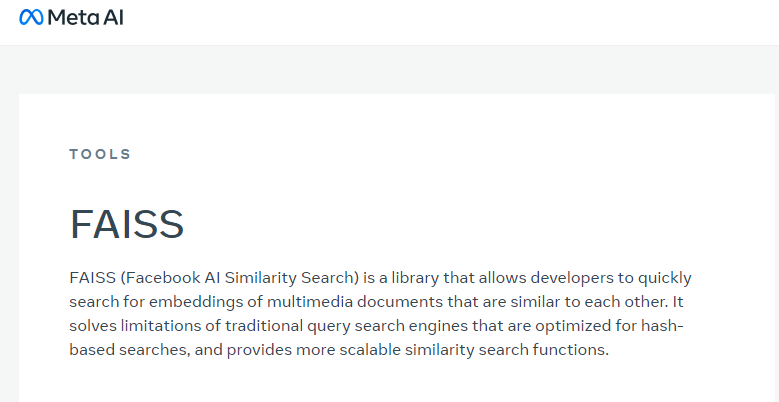
Overview: Faiss, developed by Facebook AI Research (FAIR), is a library that enables developers to rapidly search for similar multimedia document embeddings. Faiss is an efficient and versatile library for similarity search and clustering of dense vectors.
Features
- Vector Indexing: Faiss offers various indexing structures optimized for rapid similarity searches.
- GPU Acceleration: The library supports GPU acceleration, enhancing performance for large datasets.
- Quantization: Faiss employs quantization techniques for memory-efficient storage and search.
Advantages
- Lightning-Fast Search: Faiss excels in high-dimensional search scenarios, enabling rapid retrieval of similar vectors.
- GPU Optimization: GPU support accelerates search operations, making it suitable for real-time applications.
- Large Datasets: Faiss efficiently handles massive datasets without compromising on search speed.
Limitations
- Complexity: Setting up and configuring Faiss for specific use cases might require understanding its various indexing methods.
Use Cases
- Image Retrieval: Faiss powers image retrieval applications, enabling users to find similar images quickly.
- Document Similarity: The library aids in identifying documents with similar content in text-based applications.
2. Weaviate Vector Database
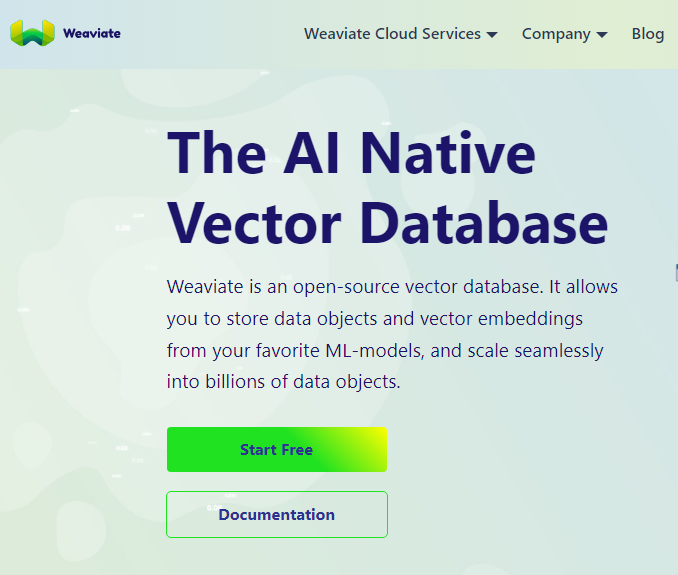
Overview: Weaviate is an open-source, cloud-native vector search engine that offers real-time search capabilities.
Features
- GraphQL Interface: Weaviate provides a GraphQL-based interface for querying and retrieving vector-based data.
- Schema Flexibility: The schema can be customized to accommodate diverse data structures and relationships.
- Real-Time Updates: Weaviate supports real-time data updates, ensuring search results remain up-to-date.
Advantages
- Real-Time Search: Weaviate excels in scenarios requiring real-time search and retrieval of vector data.
- Scalability: The cloud-native architecture enables horizontal scaling to handle growing workloads.
- Complex Relationships: Weaviate’s schema flexibility allows users to model complex relationships between entities.
Limitations
- Initial Learning Curve: Users new to GraphQL might experience a learning curve when interacting with Weaviate.
Use Cases
- Personalized Recommendations: Weaviate powers personalized recommendation engines by matching user profiles to relevant items.
- Natural Language Processing: The engine aids in processing and analyzing natural language data for semantic search applications.
3. Pinecone Vector Database
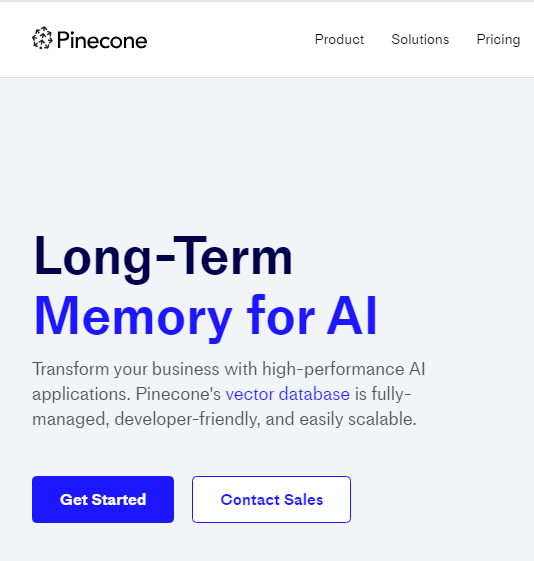
Overview: Pinecone is a cloud-native vector database designed for building high-performance search applications. It allows for storing, managing, and searching large volumes of vector data for powering AI applications.
Features
- Vector Indexing: Pinecone employs advanced indexing techniques optimized for high-dimensional vector search.
- Anomaly Detection: The platform includes tools for detecting anomalous data points in vector space.
- Integrations: Pinecone integrates with popular data processing and storage tools.
Advantages
- Lightning-Fast Search: Pinecone offers sub-second search response times even with high-dimensional data.
- Dynamic Updating: The platform supports dynamic updates to vector data, ensuring real-time accuracy.
- Anomaly Detection: Pinecone’s anomaly detection capabilities identify outliers and anomalies within data.
Limitations
- Cloud-Dependency: Pinecone’s cloud-native nature might require users to manage their infrastructure on a cloud provider.
Use Cases
- E-Commerce Search: Pinecone powers e-commerce search engines, allowing users to find similar products quickly.
- Fraud Detection: The platform aids in fraud detection by identifying unusual patterns and behaviors in data.
4. Milvus Vector database
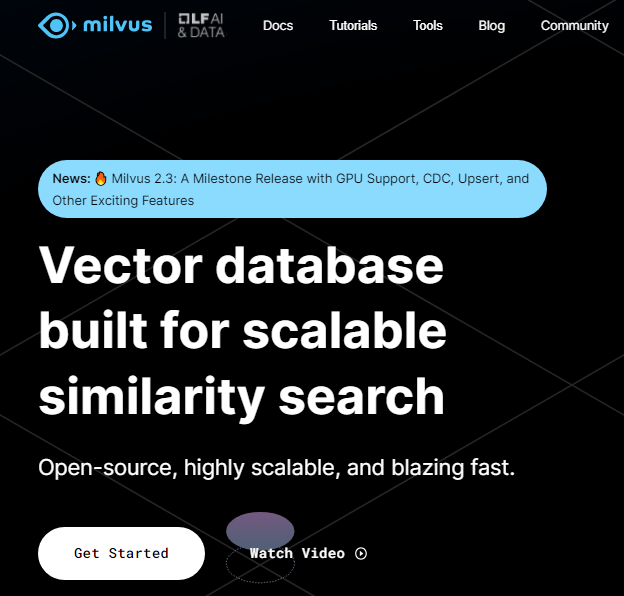
Overview: Milvus is an open-source vector database that specializes in similarity search and AI-powered applications. Key capabilities include ANN search, load balancing, high availability, and easy integration with data science ecosystems.
Features
- Vector Indexing: Milvus supports various indexing methods optimized for similarity search.
- Data Exploration: The platform offers tools for exploring and analyzing vector data through visualizations.
- Dynamic Schema: Milvus allows dynamic schema changes to accommodate evolving data requirements.
Advantages
- Rapid Similarity Search: Milvus excels in similarity search scenarios, providing fast and accurate results.
- Extensible: Its open-source nature allows users to customize and extend its functionality as needed.
- Scalability: Milvus scales horizontally to handle large-scale vector data applications.
Limitations
- Advanced Configuration: Users seeking fine-tuned optimization might need to explore advanced configuration options.
Use Cases
- Image Recognition: Milvus is ideal for image recognition applications, enabling efficient retrieval of similar images.
- Natural Language Processing: The platform supports semantic search in NLP applications by matching text vectors.
5. Redis Vector Similarity Search
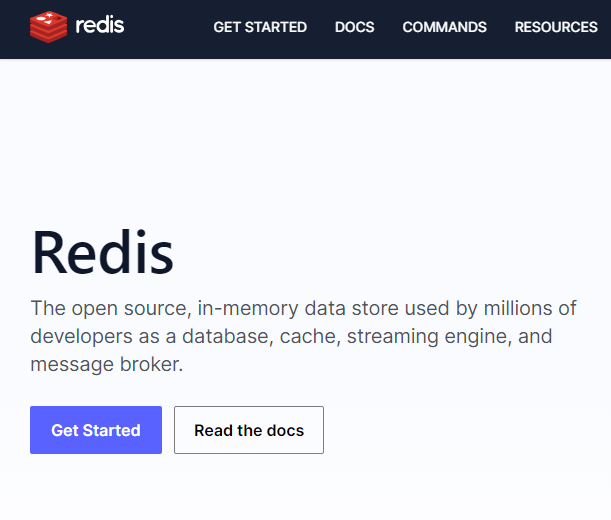
Overview: Redis, a popular in-memory data structure store, can also be used for vector storage and similarity search. Redis provides high availability, replication, Lua scripting, and a variety of data persistence options to build high-performance applications.
Features
- Sorted Sets: Redis’ sorted sets feature can be leveraged to store and retrieve vectors based on similarity scores.
- In-Memory Storage: The platform stores data in-memory, leading to low-latency access and quick search operations.
- Built-in Functions: Redis provides various functions for calculating distances and performing vector operations.
Advantages
- Low Latency: Redis’ in-memory storage ensures quick retrieval of vector data and similarity scores.
- Existing Infrastructure: Organizations already using Redis can leverage its vector storage capabilities without introducing new tools.
- Custom Functions: Redis allows users to implement custom similarity functions tailored to their use cases.
Limitations
- Limited Vector Features: While Redis can store vectors, it might lack some advanced indexing and search features of specialized vector databases.
Use Cases
- Real-Time Analytics: Redis supports real-time analytics by enabling quick retrieval of relevant vectors for analysis.
- Personalization: Organizations can use Redis to power personalized content recommendations by matching user vectors.
6. Qdrant Vector Database
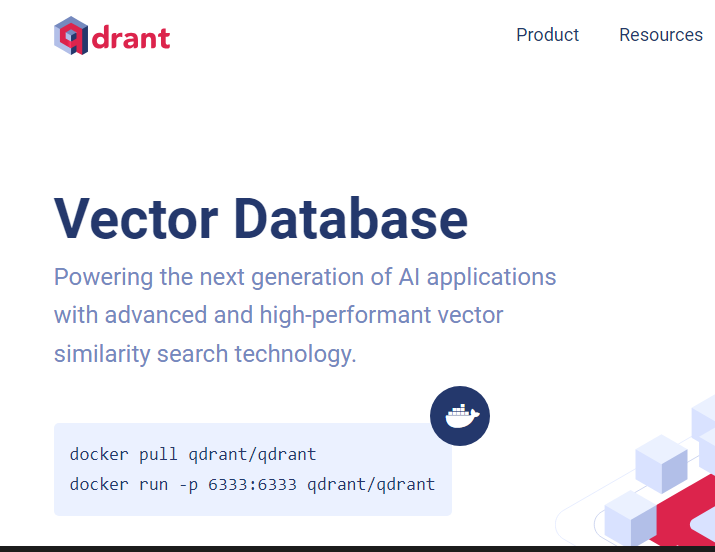
Overview: Qdrant is an open-source vector database that focuses on efficient search and retrieval of high-dimensional vectors. It uses n-dimensional vectors called multiprobes to encode data for efficient ANN lookups.
Features
- Approximate Search: Qdrant employs approximate search techniques to achieve fast search operations.
- RESTful API: The platform offers a RESTful API for easy integration and query execution.
- Multimodal Data: Qdrant supports multimodal data storage, enabling users to manage diverse types of vectors.
Advantages
- Fast Approximate Search: Qdrant’s approximate search capabilities provide quick results for high-dimensional vectors.
- Multimodal Support: The platform caters to applications where different types of vectors need to be stored and retrieved.
- Open-Source Customization: Users can modify and extend Qdrant’s functionality according to their specific needs.
Limitations
- Approximate Nature: Some applications might require exact search, where approximate search might not suffice.
Use Cases
- Audio Analysis: Qdrant supports audio analysis applications, aiding in efficient retrieval of similar audio clips.
- Recommendation Systems: The platform powers recommendation systems by matching user preferences to relevant items.
7. Vespa Vector Database
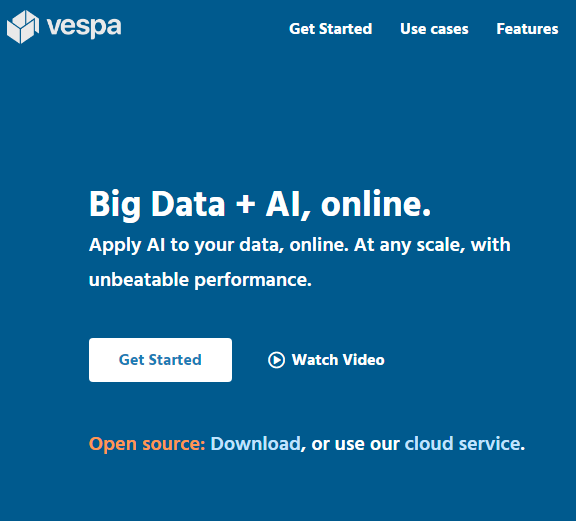
Overview: Vespa is an open-source big data processing and serving engine that can also be used for vector search. It allows storing augmented vector metadata from deep learning models and searching using vectors or keywords.
Features
- Custom Ranking: Vespa allows users to define custom ranking functions for scoring vector search results.
- Query Language: The platform offers a query language for formulating complex queries on vector data.
- Scalable: Vespa scales horizontally to handle large-scale data and search workloads.
Advantages
- Custom Ranking Logic: Vespa’s ability to define custom ranking functions provides flexibility in search result scoring.
- Big Data Processing: Organizations already using Vespa for big data processing can extend its functionality to vector search.
- Scalability: Vespa’s scalability ensures it can handle large and growing datasets.
Limitations
- Learning Curve: Users new to Vespa might need time to understand its query language and ranking mechanisms.
Use Cases
- Content Discovery: Vespa powers content discovery platforms by enabling users to find relevant articles, videos, and other content.
- Contextual Search: The platform supports contextual search, allowing users to find relevant information based on various attributes.
8. Elasticsearch Vector Database
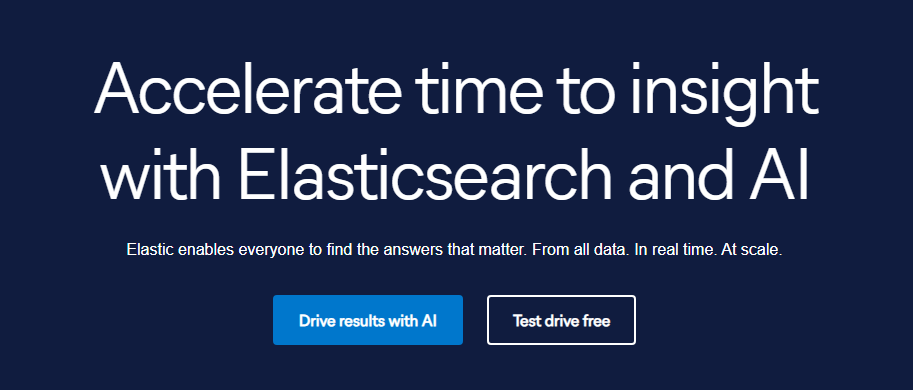
Overview: Elasticsearch, a widely used search and analytics engine, can also be extended for vector search applications. Elasticsearch stands as a distributed, open-source search and analytics engine that finds its roots in Apache Lucene and is developed using Java programming.
Features
- Dense Vectors: Elasticsearch supports dense vector fields, enabling storage and retrieval of vector data.
- vector indexings: Support for dense vector indexing and similarity search.
- Custom Similarity Scoring: Users can define custom similarity scoring functions to rank search results.
- Query DSL: Elasticsearch’s Query DSL allows users to create complex queries for vector-based searches.
Advantages
- Familiarity: Organizations already using Elasticsearch can leverage its vector search capabilities without introducing new tools
- Customization: Users have the flexibility to define custom similarity functions and adapt the search process as needed.
- Scalability: Elasticsearch’s scalability ensures it can handle diverse workloads and growing datasets.
Limitations
- Sparse Vectors: Elasticsearch’s support for dense vectors might not be suitable for applications with sparse vectors.
Use Cases
- Product Search: Elasticsearch powers e-commerce product search engines, allowing users to find similar products.
- Semantic Search: The engine supports semantic search in text and image data, enabling more accurate retrieval.
9. Vald Vector Database
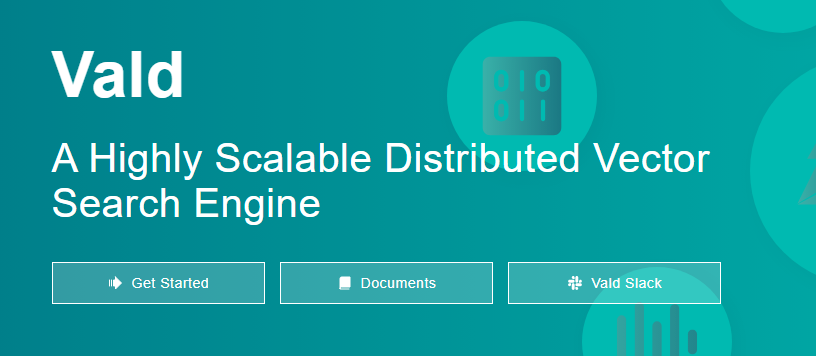
Overview: Vald is an open-source distributed vector search engine designed for high-speed similarity search operations. It has been designed and developed to meet many requirements, such as stability, disaster recovery capabilities, and performance requirements.
Features
- Distributed Architecture: Vald’s architecture enables horizontal scaling for handling large volumes of data.
- Approximate Search: The engine supports nearest neighbor search techniques for fast and efficient retrieval.
- Extensible: Vald’s open-source nature allows users to contribute and extend its functionality.
Advantages
- Scalability: Vald’s distributed architecture ensures high performance even with extensive datasets.
- Approximate Search: Approximate search techniques enable Vald to achieve low-latency search operations.
- Versatile: Vald supports various types of vector data, from images to text embeddings.
Limitations
- Distributed Management: Users need to manage and maintain the distributed infrastructure for optimal performance.
Use Cases
- Image Recognition: Vald is ideal for image recognition applications that require quick retrieval of similar images.
- Anomaly Detection: The engine supports anomaly detection by identifying unusual patterns in high-dimensional data.
10. Deep Lake Vector Database
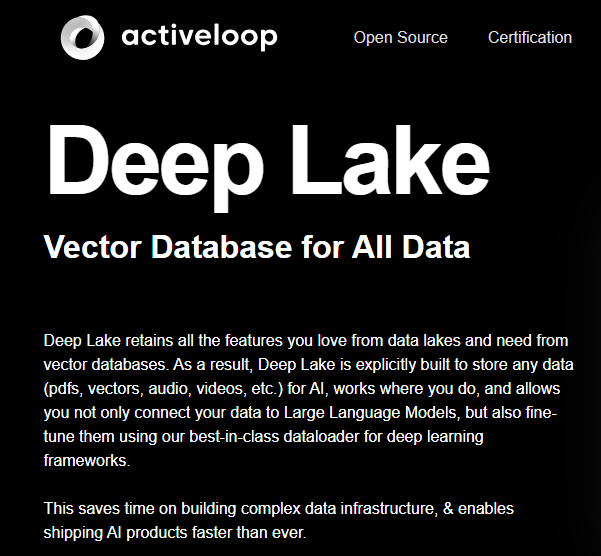
Overview: Deep Lake is a novel vector database that combines graph representation and vector storage for enhanced search capabilities.
Features
- Graph-Vector Fusion: Deep Lake’s unique approach fuses graph and vector databases for enriched search operations.
- Graph Analysis: The platform offers tools for graph analysis and exploration of relationships between vectors.
- Distributed Storage: Deep Lake employs distributed storage for scalability and fault tolerance.
Advantages
- Graph-Enhanced Search: Deep Lake’s fusion of graph and vector databases enables more comprehensive search results.
- Complex Relationships: The platform excels in scenarios where understanding complex relationships between vectors is crucial.
- Scalability: Distributed storage ensures Deep Lake’s ability to handle large-scale data.
Limitations
- Learning Curve: Users might need time to understand the unique fusion of graph and vector concepts.
Use Cases
- Social Network Analysis: Deep Lake supports analyzing social network data, identifying influencers and connections.
- Biomedical Research: The platform aids researchers in analyzing complex relationships within biomedical data.
How to Choose The Right Vector Database?
How do you choose the right vector database that suits your requirements and aids you in managing and analyzing your data effectively? When selecting the optimal vector database for your needs, keep factors like scalability, data model, and integration capabilities in mind. Here are some important aspects to think about:
Scalability and Performance: Look into how well the database can handle the amount of data and dimensions you need. Check its performance metrics, including how quickly it responds to queries and its overall throughput. Make sure it can handle the demands of your work effectively.
Data Model and Indexing Methods: Understand the data model the vector database offers. Ensure that it supports flexible schema designs. Examine the indexing methods it employs to ensure efficient similarity searches and data retrieval. Common indexing strategies include tree-based structures, locality-sensitive hashing (LSH), and approximate nearest neighbor (ANN) algorithms.
Ease of Use: Consider how easy it is to set up, configure, and maintain the vector database. A user-friendly design and comprehensive documentation can significantly impact how quickly you can learn and adapt to using it.
Integration: Check how well the vector database integrates with your existing systems, tools, and programming languages. Look for features like APIs, connectors, or software development kits (SDKs) that facilitate integration. Compatibility with popular frameworks and data processing tools is important for a seamless experience.
Community and Support: A thriving community provides access to valuable information, discussion forums, and expert advice. Evaluate the level of support offered by the database developers, including tutorials, documentation, and responsive customer support.
License Costs: Take into account any licensing or subscription fees associated with the vector database. Compare the pricing structure against your budget and the benefits the database offers to ensure it aligns with your financial goals.
Considering these factors can make an informed decision when choosing a vector database that best matches your needs for efficient data management and analysis.
Conclusion
Vector databases play a crucial role in the field of AI. They are effective tools for storing, finding, and sorting through intricate and unorganized information. These databases are particularly valuable for managing sizable language models and facilitating more intelligent searches. They offer a lasting memory and a profound comprehension of the significance of data for AI models.
With the utilization of vector databases, companies can enhance their data handling, swiftly identify similar items, and offer improved suggestions.
RedBlink is an AI consulting and generative AI development company, offering a range of services in the field of artificial intelligence. With their expertise in ChatGPT app development and machine learning development, they provide businesses with the ability to leverage advanced technologies for various applications. By hiring the skilled team of ChatGPT developers and machine learning engineers at RedBlink, businesses can unlock the potential of AI and enhance their operations with customized solutions tailored to their specific needs.

Director of Digital Marketing | NLP Entity SEO Specialist | Data Scientist | Growth Ninja
With more than 15 years of experience, Loveneet Singh is a seasoned digital marketing director, NLP entity SEO specialist, and data scientist. With a passion for all things Google, WordPress, SEO services, web development, and digital marketing, he brings a wealth of knowledge and expertise to every project. Loveneet’s commitment to creating people-first content that aligns with Google’s guidelines ensures that his articles provide a satisfying experience for readers. Stay updated with his insights and strategies to boost your online presence.
